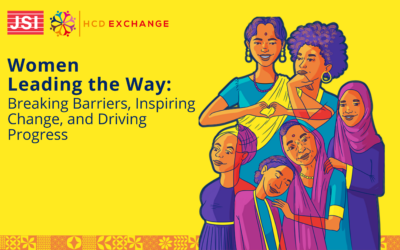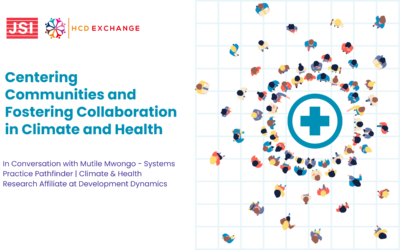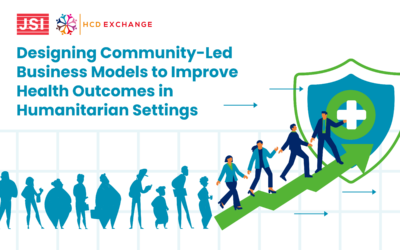This article is based on an interview with Swarali Pandare, a young designer in India. It is the second of two articles and highlights Swarali’s experience and learnings on the technical application of HCD within a Public health project for the first time. To read PART 1 of this article click here.
Swarali is a young designer based in India who has recently used HCD within a public health program. During her interview she highlighted and maintained that the process and directives of HCD are flexible and abstract enough for adaptability to different areas of work and contexts. She also argues that the HCD process does not need to be followed in a streamlined way.
“In the past, I would want to follow HCD exactly – step by step. Empathize, then define, then ideate, then prototype and test. But through work I learned that it’s a lot more loose than that and it’s a lot more needs based. So depending on the need of the project, the information you’re getting, depending on timelines, and depending on the scope and what you can do, you can use HCD and it just sort of has to make sense in a logical way. Like you have to be able to reason it out.”
The project that Swarali worked on at TinkerLabs aimed at increasing the uptake of contraceptives in a rural part of a state in North India, within a migratory environment. This project had been underway for about three years, from around the time of the COVID-19 pandemic. By the time she joined, much of the groundwork, including design research and solution testing had already been completed. The solution included a set of tools that were designed to be integrated into different touchpoints of the system in order to collectively facilitate the adoption of modern contraceptives. A first round of testing had also been completed and when Swarali started working on the project, a pilot implementation was going to be done over a three-month period to test the effectiveness of these tools in the long term. This phase, as Swarali notes, was not just about re-testing but also about actively implementing the tools in real-world scenarios.
Swarali noted that while the team had conducted research before, the composition of the team had changed, which impacted the understanding the new team had of how findings had been translated into actionable solutions. To add to that, upon revisiting the field, the team found that circumstances had shifted, particularly post the pandemic, requiring adjustments to their initial strategies for solutions. Despite the extensive work that had gone into developing these solutions, the team had to reassess and modify the solutions to align with the new realities that they were now seeing in the field. Swarali also appreciates how this was seen not as a setback but as an opportunity by the team to refine their approach, ultimately leading to better outcomes that would integrate well with the environment of the women that were being designed for.
“I think we took it quite as something that wasn’t really intended, but still was quite a positive thing. So nobody was upset that the solutions were not working the way we expected. But we kept the things that were working and we worked on improving the rest with the new information that we were getting. It was a little challenging because a lot of work had already gone into the solutions, and it meant that we would have to work extra hard to make the timeline and still have good solutions, but it paid off in the end.”
Swarali further highlights the value of incorporating a systems lens into their work. She provides context by stating that the team needed to consider not just the immediate users and community health providers – called ASHA workers in India – but also the broader system within which these people operated. Taking a system lens ultimately involved understanding the constraints of the public health system and the social structures that influence contraceptive uptake among women in rural areas.
“We had to consider what is feasible, what is the system capable of? And how much can we affect the system? Because again, this project is very local, we are creating something that the people who are living there would use to understand contraception or the last mile of the system will use to impact uptake of contraception, it’s not policy level design and neither they nor we have the power to change the system…So we have to design the solutions within the range that we can work in. And this is to say that constraints are useful, but they’re also challenging.”
Swarali reiterated that the existing public health infrastructure plays a crucial role in how women access and decide to use contraceptives, influenced by family, peers, and their access to services. Swarali stressed the importance of understanding how different factors, from community health worker behaviors to larger government policies, impact the delivery and accessibility of contraception.
“We had to understand the public health system – first of all, what is the existing way for the women in rural areas to access contraceptives? How do they find out about contraceptives in the first place? That’s all part of understanding the public health system as well. And also, the family systems or the social systems, what are the prevalent views on contraception? How they decide whether they want to use contraceptives or not is also based on what their family says and what their peers say, and on what information they get from the health system and the health workers. And also just the delivery itself is based on how the supply chain works, like whether they have a supply of contraceptives at the moment. If a woman needs contraceptive pills right now, does the health worker have it right now, and if she doesn’t what does she do about it? Or is she even able to access what she wants to access right now? And then there are other factors like how the health worker works is affected by the state and national policies which are affected by things like local politics and the incentive structure that is in place.”
Balancing these complex and interrelated dynamics was challenging but essential for creating solutions that were both feasible and effective within the environment. Ultimately, the team’s efforts to integrate a systems perspective significantly improved the project’s outcomes, despite it being challenging.
Swarali discussed the complexities faced by their project team when thinking about contraceptive use and family planning decisions among couples. The team noted that there was inherent tension in such scenarios, particularly within traditional social structures that curb women’s autonomy in decision-making. The team recognized that in many contexts, decisions about whether to have or not and when to have children were not solely in the hands of women but were influenced by their partners, in-laws and broader social norms around family -planning. Swarali emphasized that while the goal was to encourage joint decision-making between couples, they had to accept that change could not be imposed but had to be negotiated within existing social structures. Eventually, the solutions designed by the team sought to gradually increase women’s autonomy by supporting them in discussing with their partners and leveraging the social structures around them to their advantage. Furthermore, the project tried to model and facilitate healthier communication between partners regarding family planning. Swarali highlights that the team was careful to respect individual and cultural preferences regarding family size and contraceptive use, while promoting government guidelines on child spacing as recommendations rather than mandates. The overarching challenge was balancing respect for cultural norms with the promotion of new practices that might improve individual choice and well-being. This balance required a nuanced understanding of the local context and an incremental approach to change, acknowledging that a complete shift of societal norms was unlikely within the project’s timeframe.
“In the context that we were working in we had to acknowledge that it’s not completely up to one person to make a decision. We were trying to encourage the behavior that it should be a decision made by the couple but we had to acknowledge that this may not be possible. First of all, we cannot force people to behave in ways that make sense to us and that don’t make sense to them. We have to acknowledge that there is a social structure around them that also will impact how the solution is perceived and how they can and will see decision making. So the project aimed to increase the agency of women to make the decision for themselves. But one year of implementation cannot flip the agency of all women directly to 100%. One solution cannot do that. So we had to be okay with incremental change.”
Swarali also discussed the diverse perspectives within the team that was working on this project highlighting how different team members came with different skill sets and focused on different things. For example, she highlighted the focus on semiotics by one of their colleagues. This focus was crucial in understanding how visual symbols were interpreted differently by the different groups they were engaging with, including women and public health stakeholders. The team member’s approach was to analyze how well the intended messages, such as the side effects of health interventions, were being understood based on the visual representations used. Swarali elaborated on the challenges of how the team had to ensure that these symbols resonated across different visual languages, noting instances where some individuals instantly recognized and understood the visuals while others were hesitant or did not respond. This dissonance nudged the team to assess whether the lack of response was due to unfamiliarity with the visual language or a reluctance to engage in discussion. These reflections and insights were important for refining the communication strategies to be more inclusive and effective for the broader population.
Furthermore, Swarali spoke about the constraints of working with limited resources. The team adjusted their original solutions which might have been more resource-intensive to fit within the practical limitations of their contexts. This involved rethinking how to effectively deliver on the goals of the project within existing social structures and systems while ensuring scalability and sustainability. The goal was to design solutions that were simple enough for wider adoption, even among those who were not involved in the design process, ensuring that the project’s impact was both far-reaching and lasting. The team’s aim was to minimize failures and enhance outcomes, while acknowledging that they were not in control of the entire process, but also appreciating that they were in a position to be able to potentially and significantly influence the impact through strategic design and implementation.
This article has been written by Rimjhim Surana, and edited by Swarali Pandare and Belindar Kwamboka




